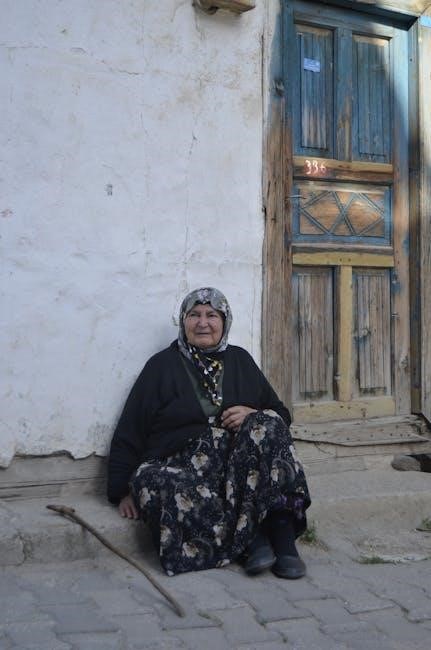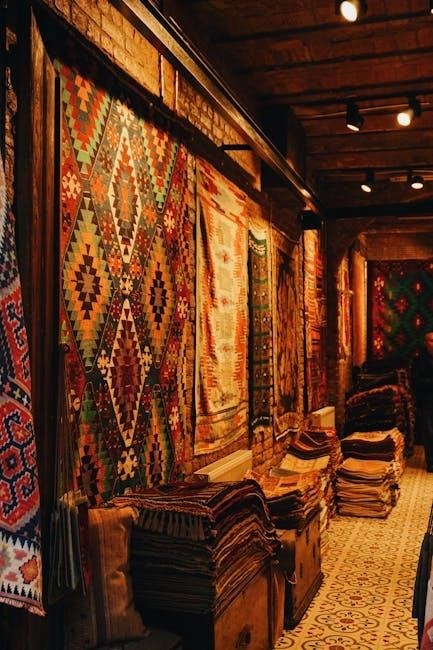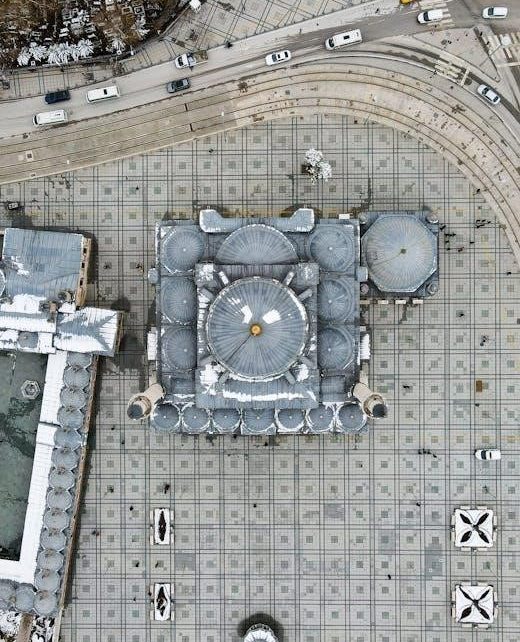World History: Patterns of Interaction explores the interconnectedness of human societies through time, focusing on cultural exchange, trade, and conflict.
By studying these patterns, students gain insights into globalization, cultural diversity, and the shared experiences that shape our modern world.
Overview of the Concept
World History: Patterns of Interaction focuses on understanding how human societies have interconnected across time and space. This concept explores the exchange of ideas, goods, and cultures, as well as the conflicts that have shaped global dynamics. By examining these interactions, the study reveals how civilizations have influenced one another, leading to cultural diversity and conflict. The approach emphasizes the cyclical nature of historical events, such as the rise and fall of empires, technological advancements, and the impact of globalization. This framework helps students analyze the complexities of human history and its relevance to contemporary issues, fostering a deeper understanding of our shared global heritage.
Importance of Studying Global Interactions
Studying global interactions is crucial for understanding the interconnectedness of human societies and the forces that have shaped the modern world. By examining historical patterns of trade, cultural exchange, and conflict, students can gain insights into the complexities of globalization and its impact on diverse cultures. This approach fosters critical thinking and encourages reflection on how past interactions influence present and future challenges. Understanding these dynamics helps individuals appreciate cultural diversity, recognize recurring historical trends, and make informed decisions in an increasingly interconnected world. Ultimately, this study equips learners with a global perspective, essential for navigating the complexities of the 21st century.
Structure of the Article

Foundational Concepts in World History
Foundational concepts in world history include human migration, the rise of civilizations, and the development of trade networks, shaping cultural and economic exchanges globally.
Human Migration and Early Civilizations
Human migration from Africa, beginning around 70,000 years ago, laid the foundation for the spread of early civilizations. These movements were driven by climate change, resource availability, and the quest for habitable lands. Early civilizations, such as those in Mesopotamia, Egypt, and the Indus Valley, emerged near fertile river valleys, fostering agriculture and urbanization. These societies developed complex systems of governance, religion, and trade, setting the stage for global interactions. The exchange of ideas, technologies, and cultures during this period shaped the course of human history, creating interconnected communities that continue to influence modern societies.
The Emergence of Trade Networks
The emergence of trade networks marked a pivotal shift in global interactions, fostering economic and cultural exchange across vast distances. Early trade routes, such as the Silk Road and maritime networks in the Indian Ocean, connected regions like Mesopotamia, China, and the Mediterranean. These networks facilitated the exchange of goods, including spices, textiles, and metals, while also spreading ideas, religions, and technologies. The rise of trade networks not only enriched economies but also deepened cultural understanding, laying the groundwork for more complex patterns of interaction in later centuries. This period highlights the transformative power of commerce in shaping human history and global connectivity.
Cultural Exchange and Its Impact
Cultural exchange has been a cornerstone of global interaction, fostering mutual understanding and innovation across civilizations. Through trade, migration, and diplomacy, ideas, religions, and technologies spread rapidly, shaping societies. For instance, the Silk Road facilitated the exchange of Buddhism from India to China and the transmission of Greek knowledge to the Islamic world. Similarly, the Columbian Exchange introduced crops like maize and potatoes to Europe, revolutionizing agriculture. These exchanges not only enriched cultures but also laid the foundation for modern globalization, illustrating the profound impact of cross-cultural interactions on human progress and diversity.

Patterns of Interaction Across Time
Historical interactions reveal recurring themes such as trade, migration, and cultural diffusion, shaping societies and fostering global connections across different eras and civilizations.
Ancient Empires and Their Legacies
Ancient empires, such as Rome, China, and Persia, established complex systems of governance, trade, and culture that shaped global interactions. Their legacies include legal frameworks, architectural innovations, and philosophical ideas. Empires facilitated the exchange of goods, ideas, and technologies across vast regions, fostering interconnectedness. For instance, the Roman Empire’s infrastructure and legal systems influenced modern governance, while China’s Great Wall and Silk Road symbolize enduring cultural and economic ties. These empires’ interactions laid the groundwork for future civilizations, demonstrating how power, culture, and trade have historically intertwined to shape the world.
Religious and Philosophical Movements
Religious and philosophical movements have profoundly shaped global interactions, spreading ideas and values across vast regions. Buddhism, Christianity, and Islam, for example, expanded through trade routes and migration, influencing cultures and societies. Philosophical traditions, such as Confucianism in China and Greek philosophy in Europe, shaped governance, ethics, and education. These movements often intersected, fostering cross-cultural dialogue and exchange.
The legacies of these movements are evident in modern societies, where religious and philosophical principles continue to inspire tolerance, justice, and human rights. Their impact underscores the enduring power of ideas in shaping global history and fostering interconnectedness among diverse civilizations.
Technological Advancements and Their Influence
Technological advancements have been a driving force behind global change, enabling societies to adapt and interact in new ways. From the invention of the printing press, which spread knowledge widely, to the steam engine, which revolutionized industry and transportation, technology has reshaped human life. The digital revolution, including the internet and mobile devices, has connected the world like never before, fostering rapid communication and economic interdependence. These innovations have not only transformed daily life but also created new opportunities for collaboration and conflict. The impact of technology continues to shape modern societies, influencing everything from education to warfare and global governance.
Key Themes in Global Interactions
Key themes in global interactions include trade, cultural exchange, conflict, and cooperation, shaping societies and fostering globalization across history.

Colonization and Its Effects
Colonization profoundly shaped global interactions, transferring goods, ideas, and cultures between colonizers and colonized peoples. It fostered economic growth through resource extraction but led to exploitation, cultural suppression, and displacement of indigenous populations. The legacy of colonization is evident in modern political, economic, and social structures, influencing identities and global inequalities. Its impact remains a critical theme in understanding historical and contemporary global dynamics.

Industrialization and Globalization
Industrialization and globalization transformed global interactions by creating interconnected economies and societies. Technological advancements, such as the steam engine and telegraph, facilitated trade and communication across vast distances. Mass production and industrial growth in Europe and North America spurred global economic interdependence. Globalization expanded cultural exchanges, blending traditions and ideas worldwide. However, it also led to resource exploitation, environmental challenges, and social inequalities. These processes underscore the dynamic and often unequal nature of global interactions, shaping modern economic systems and cultural identities. Understanding these patterns is crucial for addressing contemporary global issues.
Conflict and Cooperation Among Nations
Throughout history, nations have engaged in both conflict and cooperation, shaping global dynamics. Wars, such as World Wars I and II, highlighted the devastating consequences of rivalry, while alliances and treaties revealed the potential for unity. The rise of international organizations like the United Nations exemplifies efforts to foster cooperation and prevent future conflicts. Economic partnerships, such as trade agreements, further illustrate how nations collaborate for mutual benefit. However, geopolitical tensions and resource competition persist, showcasing the complex interplay between conflict and cooperation. These patterns underscore the dual nature of global interactions, emphasizing the need for diplomacy and understanding to navigate an interconnected world.

Periodization of World History
Periodization divides history into distinct eras, such as prehistory, ancient civilizations, and modern times, helping to organize and analyze the progression of global events and cultural developments.
Prehistory and Early Societies
Prehistory marks the dawn of human existence, with origins in Africa and the migration of early humans across the globe. The development of language and spirituality, as seen in symbolic art and ritual burials, highlights cognitive advancements. Early societies transitioned from nomadic lifestyles to agricultural communities, fostering the rise of complex civilizations. The emergence of cities like Ur in Sumer exemplifies this shift, showcasing organized governance, trade, and cultural practices. These foundational developments laid the groundwork for the interconnected world we know today, emphasizing the importance of understanding our shared human beginnings and their enduring impact on global patterns of interaction.
The Rise of Complex Civilizations
The rise of complex civilizations marked a significant shift in human history, transitioning from small, agrarian communities to organized, urban centers. Early cities like Ur in Sumer exemplified this transformation, with structured governance, specialized labor, and advanced record-keeping systems. The development of writing, trade networks, and religious institutions further solidified these civilizations’ foundations. These societies laid the groundwork for future cultural, economic, and technological advancements, illustrating the interconnected nature of human progress. The patterns of interaction during this era, such as trade and cultural exchange, set precedents for the global connections that define modern societies, emphasizing the enduring legacy of these early civilizations.

Modern and Contemporary Eras
The modern and contemporary eras are characterized by unprecedented globalization and technological advancements that have deeply interconnected the world. These periods saw the rise of industrialization, global trade networks, and the emergence of new political ideologies. Cultural exchange became more dynamic, with ideas and innovations spreading rapidly across borders. However, this era also witnessed significant conflicts, such as World Wars, that reshaped global power structures and fostered international cooperation. The digital age further accelerated these interactions, creating a deeply interdependent world. Understanding these patterns provides insights into the complexities of modern society and the challenges of balancing progress with cultural and environmental sustainability.
Case Studies of Interaction Patterns
This section examines specific historical events and networks, such as the Silk Road, the Age of Exploration, and World Wars, to illustrate patterns of global interaction, cultural exchange, and conflict.
The Silk Road and Trade
The Silk Road was a vast network of trade routes connecting East Asia, the Mediterranean, and regions in between, facilitating the exchange of goods, ideas, and cultures. Merchants traded silk, spices, precious metals, and other commodities, while technologies like papermaking and the compass spread across borders. This network also enabled the diffusion of religions such as Buddhism and Islam, shaping cultural identities globally. The Silk Road exemplifies how economic exchange fostered cross-cultural interaction, laying the foundation for interconnectedness in world history. Its legacy underscores the enduring impact of trade on human societies and civilizations.
The Age of Exploration and Its Consequences
The Age of Exploration, spanning the 15th to 17th centuries, marked a pivotal era of global interaction. European nations like Portugal and Spain sought new trade routes, leading to the discovery of the Americas and the establishment of colonies. This period facilitated the transfer of goods, people, plants, and diseases across vast distances, reshaping economies and societies. While it fostered cultural exchange and economic growth, it also led to colonization, exploitation, and the displacement of indigenous populations. The consequences of this era remain profound, influencing modern geopolitical dynamics and cultural identities worldwide.
World Wars and Global Unity
The World Wars of the 20th century reshaped global interactions, fostering both conflict and cooperation. The devastation of these wars prompted nations to seek collective security and diplomacy. The League of Nations, established after World War I, aimed to prevent future conflicts, while the United Nations, founded after World War II, continues to promote international cooperation. These institutions symbolized a shift toward global unity, encouraging dialogue and collaboration to address common challenges. The wars also highlighted the need for economic and political alliances, such as the Bretton Woods system, to stabilize the global order. Despite ongoing tensions, such as the Cold War, the legacy of these efforts remains central to modern international relations.

Textbook Resources and Curriculum
World History: Patterns of Interaction offers a comprehensive curriculum with enhanced materials, providing teachers and students with structured resources to explore global connections and historical contexts.
World History: Patterns of Interaction Textbook
The textbook World History: Patterns of Interaction is a widely used resource that offers a comprehensive exploration of global interactions, emphasizing critical thinking and historical analysis.
It integrates diverse perspectives, fostering a deeper understanding of cultural, economic, and political exchanges that have shaped human societies across time and space.
Designed for high school students, the curriculum encourages reflective learning through structured chapters, primary sources, and engaging activities that align with modern educational standards.
Teaching Strategies for Global History
Effective teaching strategies for global history involve fostering critical thinking, cultural awareness, and historical empathy.
Teachers can use project-based learning, encouraging students to explore global interactions through collaborative projects and presentations.
Incorporating primary sources, such as texts, images, and artifacts, enhances understanding of historical contexts and perspectives.
Interactive discussions and debates help students analyze complex themes like trade, migration, and cultural exchange.
Integrating technology, such as digital timelines and multimedia resources, engages students and provides diverse learning opportunities.
These approaches create a dynamic learning environment, preparing students to navigate an increasingly interconnected world.
Online Resources for Students and Educators
Online resources for studying World History: Patterns of Interaction include comprehensive study guides, chapter exercises, and expert solutions.

Platforms like Study.com and Course Hero offer detailed summaries, practice problems, and step-by-step explanations for textbook chapters.
Educators can access teaching manuals, lesson plans, and interactive tools to enhance classroom instruction and engagement.
Additionally, websites such as Holt McDougal provide digital versions of the textbook, along with multimedia resources and assessment tools.
These online materials support both independent learning and structured teaching, making global history more accessible and engaging for everyone.
Modern Implications of Historical Patterns
Understanding historical patterns of interaction helps us recognize how past events shape today’s globalized world, influencing cultural exchange, economic systems, and political relationships.
Globalization and Its Challenges
Globalization, a modern extension of historical interaction patterns, fosters economic interdependence and cultural exchange but also presents challenges like inequality and cultural homogenization. As nations integrate, disparities in wealth and access to resources persist, highlighting the uneven benefits of globalization. Cultural identities may erode as dominant cultures spread, threatening diversity. Additionally, environmental and social issues, such as climate change and labor exploitation, arise from globalized systems. Addressing these challenges requires cooperation and equitable policies to ensure sustainable and inclusive growth, balancing progress with the preservation of local traditions and fairness for all societies involved.
Cultural Diversity and Identity
Cultural diversity, shaped by centuries of global interactions, reflects the unique traditions, beliefs, and practices of societies worldwide. Historical patterns of migration, trade, and colonization have fostered the blending of cultures while also preserving distinct identities. Globalization has amplified both the exchange of ideas and the challenges of cultural homogenization. Understanding and appreciating cultural diversity is crucial for building inclusive societies and addressing identity-based conflicts. Education plays a vital role in promoting cross-cultural understanding, enabling individuals to respect and value the rich tapestry of human experiences. By embracing diversity, we strengthen global unity while celebrating the richness of our collective heritage.
Lessons for the Future

The study of historical patterns reveals valuable lessons for addressing contemporary challenges. By analyzing past interactions, societies can foster cooperation, mitigate conflicts, and promote sustainable development. Globalization, technological advancements, and cultural exchange highlight the importance of adaptability and collaboration. Understanding historical failures, such as environmental degradation and inequality, encourages societies to adopt more equitable practices. These insights empower future generations to navigate global complexities, prioritize sustainability, and build a more inclusive world. Learning from history ensures that we avoid repeating past mistakes while leveraging its wisdom to create a brighter, shared future for all humanity.
Understanding historical patterns of interaction provides crucial insights into shaping a harmonious and interconnected global future, fostering cooperation and learning from past achievements and challenges.
World History: Patterns of Interaction highlights the interconnectedness of human societies through cultural exchange, trade networks, and migrations. Key themes include the rise of civilizations, technological advancements, and the impact of globalization. The textbook emphasizes how these interactions have shaped modern societies and global systems. By studying these patterns, students gain a deeper understanding of historical processes and their relevance to contemporary challenges. The curriculum encourages critical thinking and reflection on the complexities of human interaction, offering insights into cooperation, conflict, and cultural diversity. Ultimately, this framework provides a comprehensive view of global history, equipping learners to navigate an increasingly interconnected world.
Final Thoughts on Global Interactions
Understanding global interactions is crucial for grasping the interconnectedness of human societies. Historical patterns reveal how cultural exchange, trade, and conflict have shaped the modern world. By studying these dynamics, we gain insights into the complexities of globalization and its impact on diverse cultures. The interconnectedness of the world underscores the need for cooperation and mutual understanding; While historical interactions have often been marked by both cooperation and conflict, they remind us of the importance of learning from the past to build a more unified and equitable future. Embracing this perspective fosters a deeper appreciation for the shared human experience and the challenges we face collectively.
Encouragement for Further Study
Exploring the patterns of interaction in world history offers a rich and rewarding journey into the complexities of human societies. By delving into primary sources, historical texts, and diverse perspectives, students can gain a deeper understanding of how global connections have shaped cultures, economies, and ideologies. Encouraging further study fosters critical thinking, empathy, and a broader worldview. Engaging with resources like World History: Patterns of Interaction provides a structured approach to analyzing these dynamics. Participating in discussions, attending workshops, and exploring digital archives can further enrich this educational experience. Embracing lifelong learning in this field empowers individuals to navigate an increasingly interconnected world with insight and confidence.



